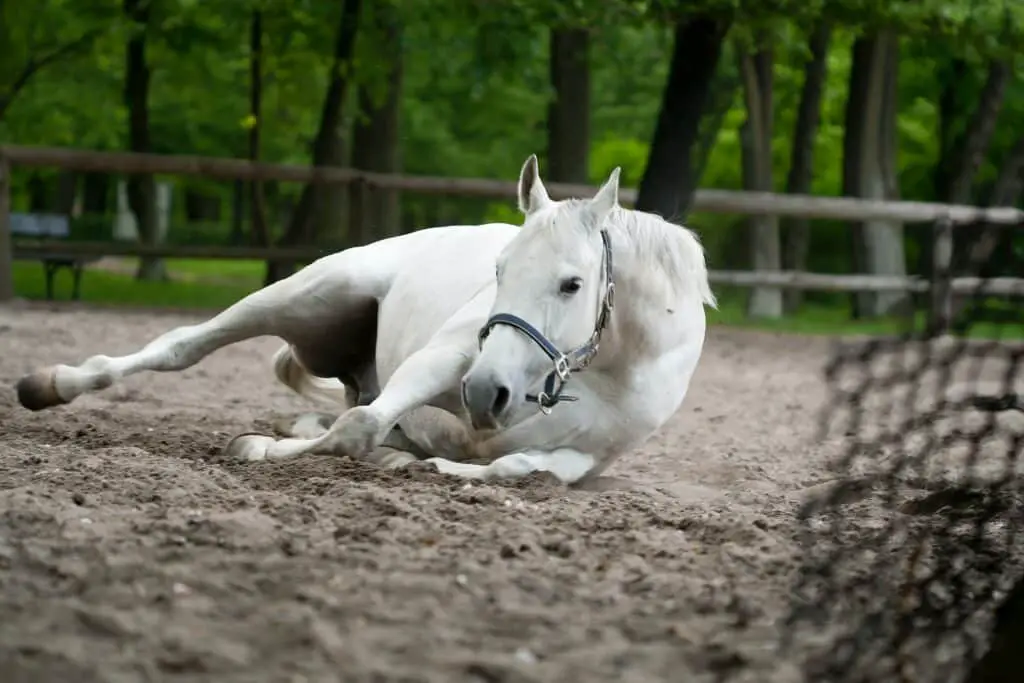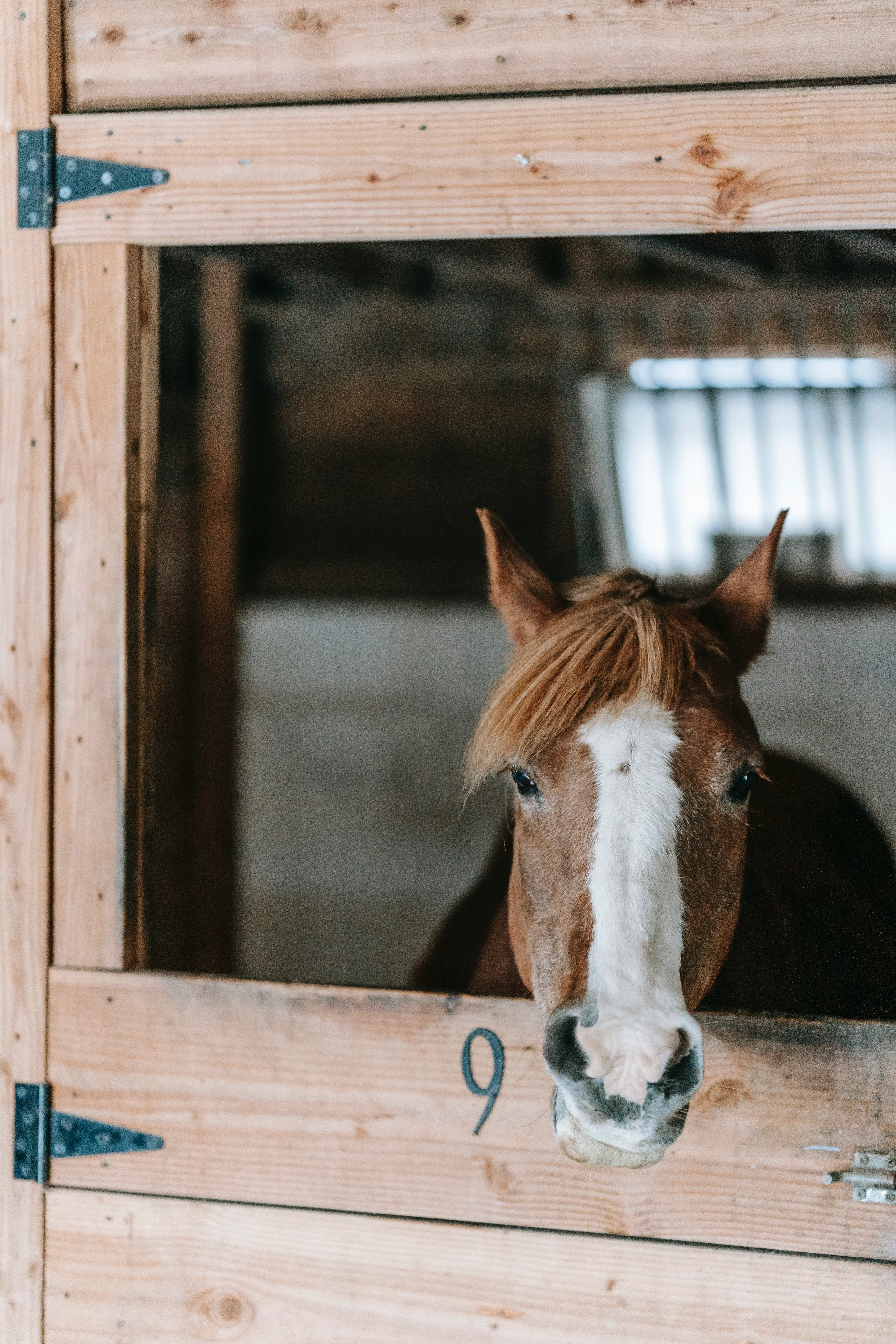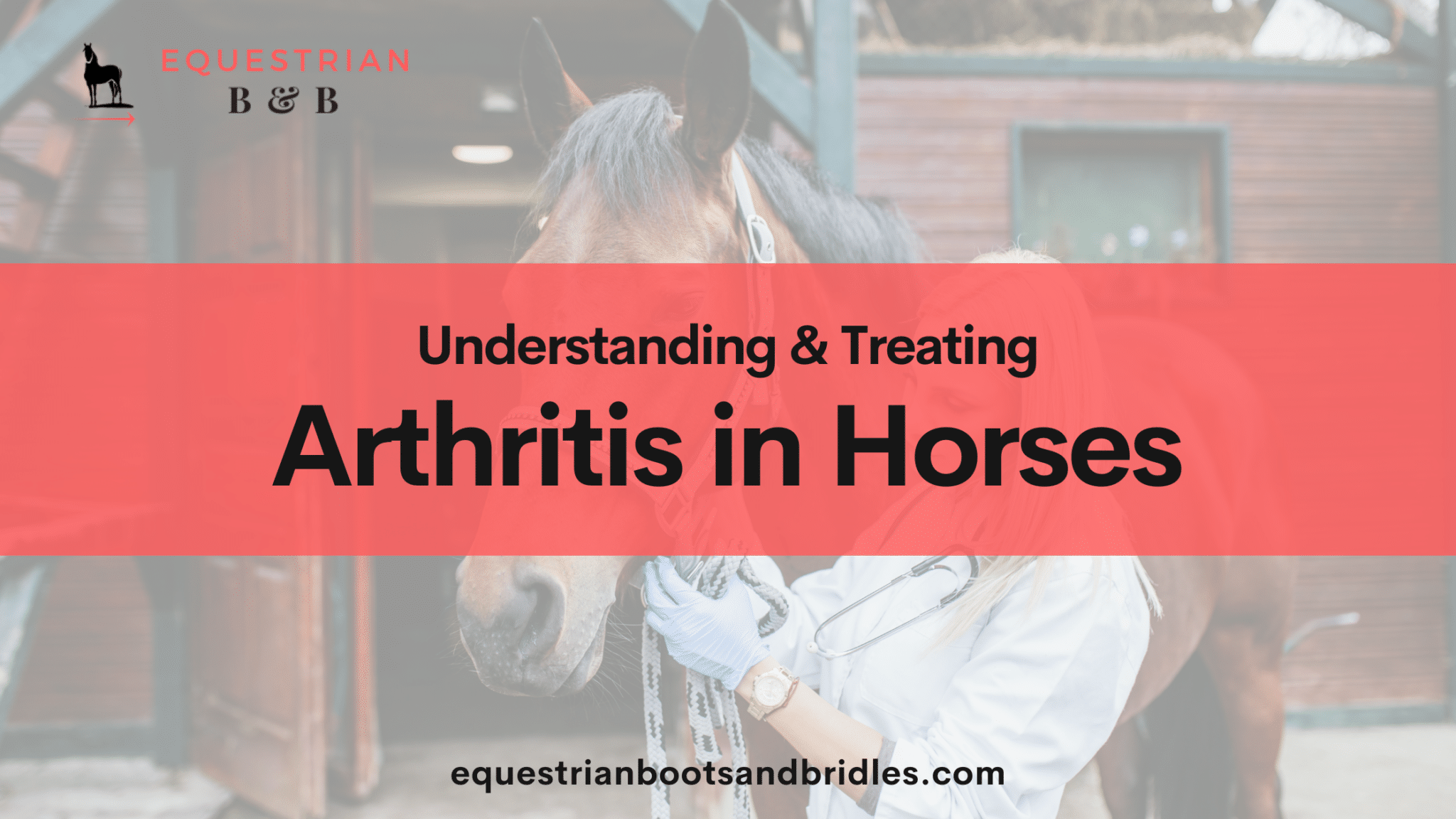There comes a time when most horses will begin to slow down. They seem to walk a little slower, step a little more cautiously, and the odd click and clack sounds start popping out of their joints when they step just a little awkwardly. Perhaps they also start being lame or walk stiffly more often, especially in winter. As a horse owner, you probably suspect it’s the dreaded A-word: arthritis.
But what exactly is arthritis in horses? Is it like osteoarthritis, and how do you treat these to keep your equine partner comfortable and in work for as long as possible? Let’s find out.
As always, the information in this article is for informational purposes only and should not be considered medical advice for your horse. You should always consult with your vet when treating your horse.
What Is Arthritis in Horses?
Arthritis, whether in horses or in people, is caused by chronic inflammation that has damaged the soft tissues of the joints. Because of this damage, the joints lose their flexibility and become stiffer. Without your joints’ flexibility, movement becomes compromised, and the thickened joints also cause moderate to severe pain.
While arthritis is a painful fate for anyone (horse or human), horses suffer particularly because of arthritis due to their large size and heavy weight. The horse’s joints have to carry more weight, and with all the delicate ligaments, tendons, and joints, horses have a much more complicated suspensory mechanism to keep them upright and moving.
Inflammation is a natural response of the body to mend micro-tears of the delicate joint tissues that are caused by injuries and daily movement. Excessive exercise and concussion can be some of the reasons that joint tissue becomes damaged, but the result is the same: inflammation. With the healing process of inflammation, the joint cartilage thickens and becomes a little less flexible each time it heals. The result is arthritis.
How Is Arthritis Different From Osteoarthritis in Horses?
When arthritis in horses goes unmanaged, and the inflammatory response increases, the condition becomes chronic, and the horse is said to have developed osteoarthritis. When a horse has osteoarthritis, they have a degenerative joint disease, which means the condition worsens over time, regardless of whether the horse is in work or simply living a quiet life.
There is no cure for arthritis and osteoarthritis in horses. Management of the inflammation in arthritis and pain management in osteoarthritis with supportive treatment can help minimize the horse’s suffering and delay the inevitable decision that a caring horse owner would have to make.
With appropriate management, early identification, and adequate supplementation, a horse can live many years without suffering and enjoy a full life.

Signs of Arthritis in Horses
If you suspect your horse has developed arthritis, you can look for the following early warning signs:
- Stiffness
- Taking longer to warm up before working through an outline
- A shorter stride on one leg
- Being slightly off on one lead or in a particular direction on the circle
- Reluctance to bend through the body or step under with hocks
- Refusal to do work they had previously been fine with, such as refusing jumps or fast walking before they go into the trot or upward transitions
When arthritis has become more advanced and osteoarthritis is setting in, you may begin noticing these signs:
- Early morning lameness when coming from their stable
- Reluctance to stand for the farrier
- Clicking sounds from joints when bending legs
- Lameness when a leg has been held in position and the horse is then asked to walk or trot forward (a typical tendon lameness test)
- Becoming frequently lame with longer rest periods needed
- Visible thickening of joints
- Becoming upset when being saddled (at the anticipation of work)
- Sudden aggression
- Bone spavin formations (boney spurs)
- Visible pain and heat from swollen joints
Areas of the Horse’s Body Most Affected by Arthritis
Arthritis requires the following to develop: soft joint tissue and concussive force or excessive force that causes chronic joint inflammation. Therefore, the area of the horse’s body that’s usually most susceptible to arthritis from injury and inflammation is the horse’s articular joints such as their legs, pastern joints, hocks, temporomandibular joint, and fetlock joints.
In cases of severe hyperflexion of the neck, the horse may develop arthritis from repeated trauma to the neck vertebrae as well. Less common areas that can develop arthritis in horses are their spinal vertebrae, stifle joints, and hips. It is rare for arthritis to develop in one joint only unless the horse sustained serious trauma or injury to that particular leg.
How Arthritis Develops in Horses
While arthritis doesn’t always develop in all horses, it is a natural process that results from regular wear and tear if the horse is slightly more prone to inflammation. The horse’s diet may also increase inflammatory responses, especially if their diet is very rich in sugar, which compromises joint health.
The horse’s joints develop micro-tears in the soft cartilage tissue, which heal through an inflammatory response. The result of these healed mini-fractures is that the soft cartilage is no longer as soft or flexible. In severe cases and due to injury, the horse’s joint capsule may become compromised, and synovial fluid may leak out, reducing the joint’s flexibility and stability. A weakened joint is more prone to chronic inflammation.
Over time, the joint continues to harden until flexibility is compromised and the horse struggles to flex their legs or bear weight. At this point, the horse’s condition is known as osteoarthritis (arthritis of the bone).
Causes of Arthritis and Osteoarthritis in Horses
As already mentioned, arthritis requires some sort of damage to the soft tissues of the joints, which triggers an inflammatory reaction, thickening the bone. Specific causes of arthritis in equine athletes may include the following:
1. Hyperextension of the Horse’s Legs
Horses are amazing athletes, but they are often pushed too far and too hard when training to compete. Racehorses are known for hyperextending their legs to run at such extreme speeds, which can result in arthritis and the formation of additional bone known as sidebone or ringbone. Showjumpers suffer pastern injuries due to repeatedly landing and launching in hyperextension to try and get extra lift to clear higher jumps.
Western horses that are used to perform high-impact maneuvers such as a sliding stop or spin may also suffer hyper extension, which can damage sensitive cartilage in the joints or cause fractures that may leak synovial joint fluids, which will compromise the joint’s flexibility.
Another sensitive cause of arthritis in horses is when a horse has to repeatedly carry a rider who is too heavy for the horse’s joints. When a horse has to bear extra weight, it increases the stresses on their joints, which leads to further pressure and potential injury, causing inflammation.
2. Concussion from Hard Surfaces
When hyperextension is combined with repetitive concussion, the risk of arthritis increases. Running horses on hard surfaces such as dirt or tar roads, rocks, and frozen ground may create excessive vibrations that can create further micro-fractures of the joint area, triggering inflammation and causing arthritis.
3. Injuries to the Joint Capsules
Injuries such as puncture wounds and wire cuts can also cause thickening of the joint capsule. If infection occurs, the horse may experience inflammation, and the affected joints may suffer septic arthritis. Even if the joint itself isn’t pierced during an injury, the surrounding soft tissues may become inflamed, which may be all it takes to start the arthritis journey.
4. Genetic Predisposition
Finally, horses may have a genetic predisposition that can cause them to have weak joints or poor quality synovial fluids. As a result, the genetic markers may lead to much earlier onset of the horse’s arthritis. Bone density may also factor in when arthritis will become active or how severe it may be.

Different Types of Arthritis in Horses
While there aren’t specific arthritis types (as in completely different forms of arthritis) for horses, they do develop different stages of arthritis and have different ways in which their bodies are affected by arthritis.
Here are a few examples of different arthritis “types” or progressions that horses may develop:
- Early Arthritis in Horses
When the horse has begun showing signs of arthritis but no significant damage has been done yet, slight swelling and mild inflammation may occur.
- Joint Arthritis in Horses
If the horse’s joints are inflamed, the joint capsule and synovial fluid becomes compromised. This is called synovitis. A common type of joint arthritis is arthritis in horses hocks.
- Osteoarthritis in Horses
Once the horse’s bones start deforming because of the formation of bone spurs and calcification of the cartilage, osteoarthritis has set in.
- Degenerative Joint Disease (DJD)
If the horse’s arthritis becomes more severe over a relatively short period, the horse may have developed DJD, which explains the acceleration of degeneration. You can read more about DJD right here.
Treatment Options for Arthritis in Horses
No rider wants their horse to suffer. In the past, horses with arthritis were retired to live out their days, until they were euthanized. Some sport horses that could no longer perform due to arthritis were killed simply because the cost of caring for an arthritic horse that had no financial value was considered unfeasible. At best, owners could add diclofenac sodium to the horse’s diet to help ease pain along with other inflammatory mediators.
Luckily, things have improved substantially for horses with arthritis.
Today, there are a range of supportive treatments available, from injections for chronic arthritis, where different medications are injected directly into the joint (especially hocks), to working with an equine nutritionist to design a diet that will help reduce inflammation.
In severe cases, it may be feasible to elect for surgery, and arthroscopic surgery has come a long way in its success to remove cartilage damage and offer significant improvement to the horse.
However, surgery is only a viable option with an early diagnosis of arthritis. If the remaining cartilage can be regenerated with platelet-rich plasma or stem cells injections, gentle daily exercise can help rebuild and maintain the existing cartilage. However, surgery and expensive injections are often outside the average horse owner’s price range.
So what can you do on a budget for your heart horse when they develop the first signs of arthritis? Here are a few options:
1. Stop All Exercise, and Rest
When the first signs of inflammation show up, you should instantly stop all exercise for at least 6 to 12 weeks. With ample rest and supportive medication to reduce inflammation, the horse may recover without any significant damage.
2. Evaluate the Horse’s Environment and Work
If your young horse suddenly shows signs of arthritis, it could be that they were put into severe work too soon, and you should rest them and then return to milder work. When working on hard surfaces, add concussion minimizing shoes and boots to help reduce vibrational forces that may damage joints.
3. Use Topical Cream to Soothe
Applying liniment ointment, which stimulates blood flow to the arthritic joint, thereby reducing inflammation, is still a staple in appropriate management of horses with arthritis. Owners also swear by topical creams that contain comfrey, aloe vera, and arnica oil. Menthol may also help reduce inflammation by drawing heat away from the joint.
4. Dietary Supplementation
Horses can also be supplemented with fish oil, which is rich in omega oils found in docosahexaenoic acid and eicosapentaenoic acid. The supplementation with omega oils have been shown to improve joint health by lengthening stride and better overall comfort.
Adding devil’s claw and rosehip to the horse’s diet can also help reduce swelling associated with arthritis, which may not cure the condition but will offer significant pain relief.

Arthritis in Horses FAQs
When is it time to put your arthritic horse down?
If your horse is not responding to arthritis treatment over a period of 60-90 days, you may want to discuss the option of euthanizing your horse with your vet when your horse is in extreme pain that negatively affects their quality of life. Should they battle to get up when they’ve laid down or lie down constantly because of pain, they are telling you it may be time.
What horses are most prone to arthritis?
Competition horses such as race horses, jumpers, and those competing in barrel racing and advanced Western games are most at risk for developing arthritis.
How long can a horse live with arthritis?
Horses can live many happy and pain-free years with arthritis if the condition is diagnosed early and treated successfully with supportive measures. Some horses with arthritis may also continue performing more gentle work such as lower levels of dressage or hacking if they have a sensible rider who knows how much work they can do without pain or inflammation.
Final Thoughts on Arthritis in Horses
If your horse gets the dreaded diagnosis of arthritis, it isn’t the end, and they can continue normal function if you manage the condition effectively. Work with your equine practitioners, vets, and therapists to reduce pain, minimize inflammation, and prevent further damage. Your horse will thank you for it.
Not all pain is arthritis based, and you can learn more about degenerative suspensory ligament disease in our guide.

